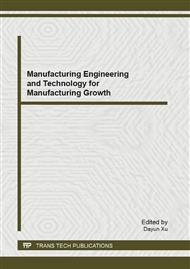[1]
J. Bajkowski, J Nachman, M. Shillor, M. Sofonea, A model for a magnetorheological damper. Mathematical and Computer Modelling, no. 48., p.56–68 (2008).
DOI: 10.1016/j.mcm.2007.08.014
Google Scholar
[2]
S.A. Mazlan, N.B. Ekreem, A.G. Olabi, An investigations of the behavior of magnetorheological fluids in compression mode, Journal of Materials Processing Technology. no. 201., pp.780-785 (2008).
DOI: 10.1016/j.jmatprotec.2007.11.257
Google Scholar
[3]
A. Muhammad, X. Yao, Z. Deng, Review of magnetorheological (MR) fluids and its applications in vibration control, Journal of Marine Science and Application, Vol. 5, No. 3, pp.17-29 (2006).
DOI: 10.1007/s11804-006-0010-2
Google Scholar
[4]
M. Ahmadian, J.A. Norris, Experimental analysis of magnetorheological damperswhen subjected to impact and shock loading, Communications in Nonlinear Science and Numerical Simulation, no. 13., p.1978–1985 (2008).
DOI: 10.1016/j.cnsns.2007.03.028
Google Scholar
[5]
I. Bica, Damper with magnetorheological suspension, Journal of Magnetism and Magnetic Materials. no. 241., p.196–200 (2002).
DOI: 10.1016/s0304-8853(02)00009-4
Google Scholar
[6]
A.G. Olabi, A. Grunwald, Design and application of magneto-rheological fluid. Materials and Design, no. 28., p.2658–2664 (2007).
DOI: 10.1016/j.matdes.2006.10.009
Google Scholar
[7]
J. Huang, J.Q. Zhang, Y. Yang, Y.Q. Wei, Analysis and design of a cylindrical magnetorheological fluid brake. Journal Material Processing Technology, no. 129. p.559–62 (2002).
Google Scholar
[8]
W.I. KORDONSKY, Magnetorheological fluids and their application. Journal of Materials Technology, vol. 8, No. 11., p.240−242 (1993).
Google Scholar
[9]
P. Martynowicz, Z. Szydło Z., Special Application Magnetorheological Valve Design Study. Scientific Aspects of Unmanned Mobile Vehicle, PTMTS, Kielce (2010).
Google Scholar
[10]
M. Kciuk, R. Turczyn, S. Kciuk, A. Mężyk, Ciecz magnetoreologiczna WIPO ST 10/C PL392656 (2010).
Google Scholar


